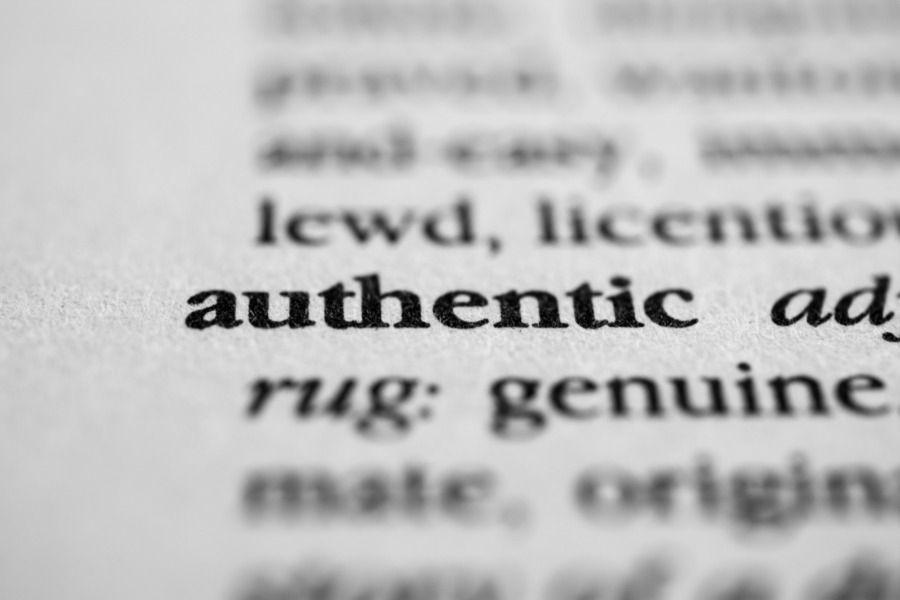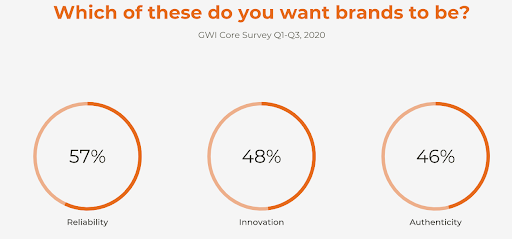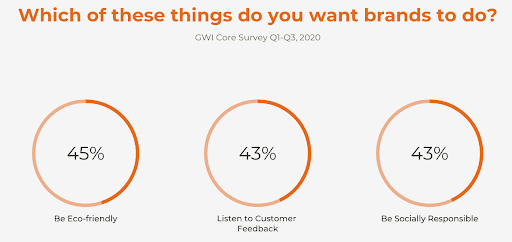
Today’s consumers expect brands to be authentic — they want real experiences that improve their lives and align with their values. In this blog post, Rituparna (from our Insight & Strategy team), explores what brand authenticity is and how brands can be the real deal – to drive consumer trust, loyalty and affinity.
What Is Brand Authenticity?
Mohart et al define brand authenticity as “the extent to which consumers perceive a
brand to be faithful and true toward itself and its consumers, and to support consumers
being true to themselves”.
In simple words, there are three elements to brand authenticity:
- Being honest to oneself
- Being honest with your consumers
- Supporting your consumers’ self-expression
Authenticity is crucial to driving brand trust, loyalty and affinity. Today, authenticity has taken precedence amongst consumers as they are constantly in search of genuine experiences that can enrich their lives in a hyper-connected world. As shown in Global Web Index (GWI), customers globally value reliability, innovation and authenticity when it comes to brands. They also prefer brands that are eco-friendly, listen to customer feedback and take social responsibility seriously. These findings clearly indicate that brands need to offer more than just a good product or service.
So who is demanding authenticity? You might think it is the Gen Z audience, who have become synonymous with online authenticity, birthed from their transparency and openness on platforms, such as TikTok. But it is actually multi-generational.
According to a 2020 WP Engine study, 82% of Gen Z will trust a company featuring actual customers in their ads and 72% feel that there is a higher chance for them to buy from brands that contribute towards social good. Interestingly, Twitter states that 90% of millennials, 85% of Gen Xers and 80% of Baby Boomers considered authenticity to be a major factor in their decision to support a brand.
As a result, in recent years, we have seen more brands making a conscious effort to showcase authenticity through their marketing campaigns. While some have been able to receive accolades and appreciation, others have got marred by controversies.
Let’s take a look at a few successful marketing campaigns, followed by some controversial ones.
Successful Marketing Campaigns That Demonstrated Brand Authenticity
Vicks’ ‘Touch of Care’ campaign
Vicks, the popular over-the-counter medication owned by P&G, was a brand I grew up using in India and one that continues to be synonymous with cough and cold remedies. Its 90s and early 2000s adverts were hinged on the idea of love and care within a traditional Indian family setup. However, in 2017, they decided to challenge the traditional concept of family by launching the ‘Touch of Care’ campaign to drive home the message that everyone deserves care.
The campaign included a series of ads based on real-life, unconventional families. The first ad looked at the life of an orphan girl adopted by a transgender woman. This was followed by a second ad telling the story of an orphan girl suffering from a genetic skin condition called Ichthyosis. It depicts her happy, fulfilled life with her adoptive parents and the love shared between them. The ad concludes with a shocking statistic — there are 29.6 million orphans in India, and in the previous year only 43 children with disabilities found a home.
During the pandemic, Vicks launched a third ad built around the inspiring story of a doctor whose dream of building a paediatric hospital for children in his hometown came to a tragic halt with his passing. The advert then went on to show how the brand helped his wife fulfil his dream by contributing towards building the hospital and keeping his legacy alive.
The thought-provoking and genuine messaging of the ads were able to strike a chord among celebrities, influencers, activists and the general public alike. This led them to receive over 70 million views on YouTube, to date, and win several accolades at The Cannes Lions International Festival of Creativity and The SABRE Awards.
Burger King’s ‘Burning Stores’ campaign
In the same year, Burger King launched the ‘Burning Stores’ campaign featuring photos of actual restaurants located in Italy, Oregon and Pennsylvania going up in flames. The campaign was based on the data that the number of Burger King restaurants that have burnt down since 1954 is greater than any other brand. The ad revealed the brand’s vulnerability and ability to be self-aware, making them appear more humane and authentic to its customers. The ad went on to win an award at the Cannes Lions Festival.
Controversial Marketing Campaigns That Damaged Brand Authenticity
Pepsi’s ad with Kendall Jenner
In 2017, Pepsi launched its infamous ad featuring Kendall Jenner. The ad showed young people banding together to join a street protest. At the front of this protest stood Jenner, who offered a can of Pepsi to a police officer, which led to a clamouring response from the protestors. The ad came across to many as tone-deaf and out of touch. The suggestion that a can of Pepsi, complete with Kendall Jenner, can solve deep-rooted issues that are worth protesting is, of course, ridiculous. The ad was launched around the time of the Black Lives Matter (BLM) protests, which heightened the backlash and caused Pepsi to ultimately pull the ad.
Dove’s ‘Real Beauty’ campaigns
Released in 2004, Dove’s ‘Campaign for Real Beauty’ has often been applauded for being a game changer for breaking stereotypes surrounding beauty ideals and celebrating women with unique differences. But the campaign has had its fair share of controversies as well. While most felt the campaign to be empowering for women, it was also contradictory. Professor Sarah Heiss argues it was based on the ideology of “naive integration” as the real women depicted in the campaign had a stark resemblance to pre-existing ideals, that women should be young, tall, slim with flawless skin. Moreover, the campaign failed to include a diverse set of women especially, women with disabilities.
Building Authentic Brands
Though building brand authenticity has become more crucial today, it is not an easy feat to achieve since authenticity is perceived to be natural, free from prejudice and commercial interest. Here are a few suggestions for building authentic brands.
Be clear and consistent
Brands need to be clear about their vision, mission and values. They need to ensure their messaging and branding aligns with this and remains consistent throughout. Consistency should be there in the brand’s personality and tone of voice across all channels.
- Everyone loves a good story. An authentic brand story helps a brand connect with its audience on an emotional level. Think about TOMS’ philanthropic story about donating a pair of shoes to a child in need for every pair sold. Sharing the story behind how the brand was founded and formed would help in establishing the rationale behind your brand’s vision, mission and values
- Consider sharing inspiring stories of your employees. This helps in humanising the people behind the brand thereby forging better and more genuine connections with consumers
- Be transparent about your brand’s supply chain and its impact on the environment. Consumers appreciate authenticity and showing you are taking steps in the right direction is key. If you are a sustainable brand but you’re struggling to communicate this message to your audience give this blog post a read
- Collaborate with influencers and participate in events that align with your brand’s core values
Be engaging
Engaging with all stakeholders is extremely important and brands need to establish a two-way communication by:
- Sharing news on social media like product launches, industry news, etc
- Addressing customer queries through contact forms, owned social media channels, chatbots, etc
- Seeking customer feedback through emails, surveys, user testing, etc
- Valuing customer opinions by asking for feedback, reviews, testimonials, etc
Build a community
Building communities is also a great way to engage with consumers. A classic example would be Harley Davidson and its community of bikers who represent the brand’s ethos and lifestyle. The brand’s community-focused positioning helped strengthen the connection between them and their consumers leading them to come out from the brink of bankruptcy in 1983 to boasting a market cap of $6.97 billion in 2022.
You can create a community for consumers that aligns with your brand. However, to do so you need to ensure three things:
- Identify a compelling reason for your consumers to join the community. For instance, if you are a fitness brand, consider creating a social media forum for your consumers to voice their concerns, share their fitness journey and goals.
- Make it worthwhile for your consumers to engage with the brand and with each other. As a fitness brand, you might want to share diet and workout recommendations, as well as conduct polls and surveys to keep them engaged.
- The community needs to be valuable enough so that your consumers willingly share it with their friends and family, thereby increasing its user base. Think about hosting a live session or an on-ground event with a fitness expert to share tips and address any queries and concerns.
Be innovative
There is a way to be innovative and stay ahead of the curve, whilst also staying in touch with your brand’s roots. In fact, this is the winning formula. While conducting a 2017 annual global consumer survey, which involved ranking the top 20 brands in the US based on authenticity, Cohn & Wolfe found that consumers wanted brands to innovate despite having an established history.
A case in point would be Netflix which moved from DVD rentals to online film streaming. It was able to stick with the value proposition of entertaining the world while changing the medium through which it delivered, from DVDs to online.
There are many ways by which you can innovate, such as:
- Leveraging company data and insights
- Encouraging employees and consumers to share ideas
- Experimenting and researching
However, when it comes to innovation, remember not to hasten the process as major changes happen over time.
It’s never too late for brands to take the authentic route, but it needs to be executed in the right way and for the right reasons. If you have any queries about authentic brand building or your digital marketing strategy, get in touch with our Insight and Strategy team at Passion Digital.
 Passion Digital
Passion Digital 


